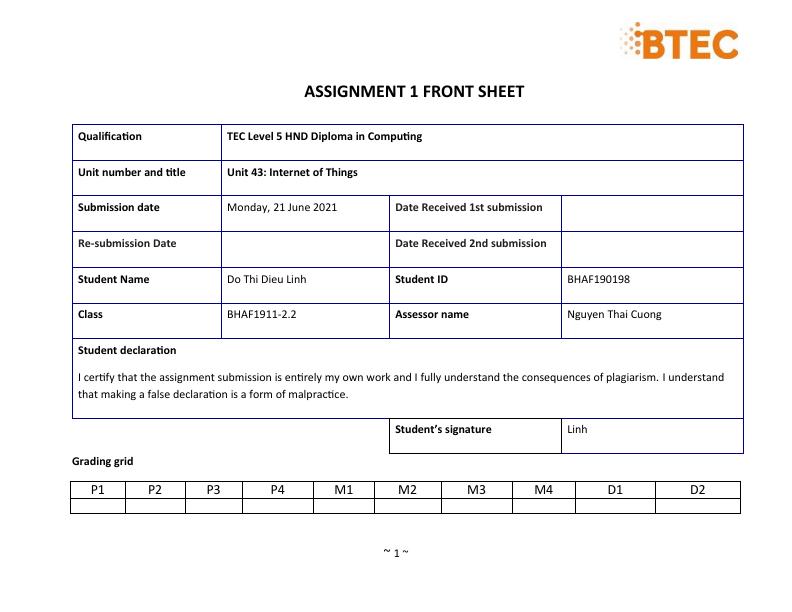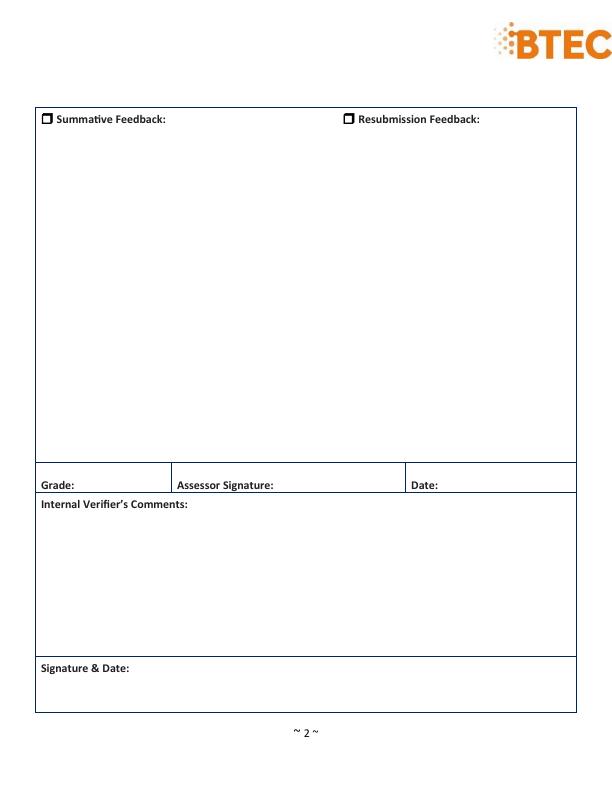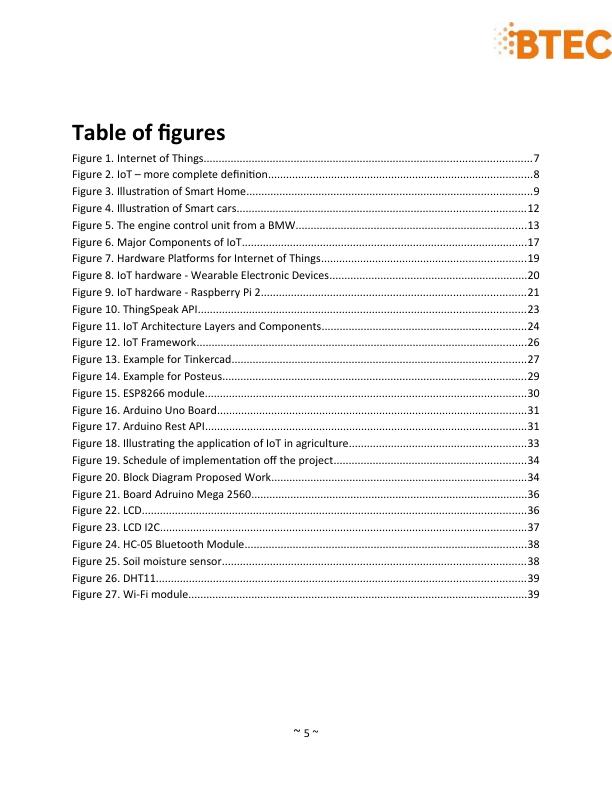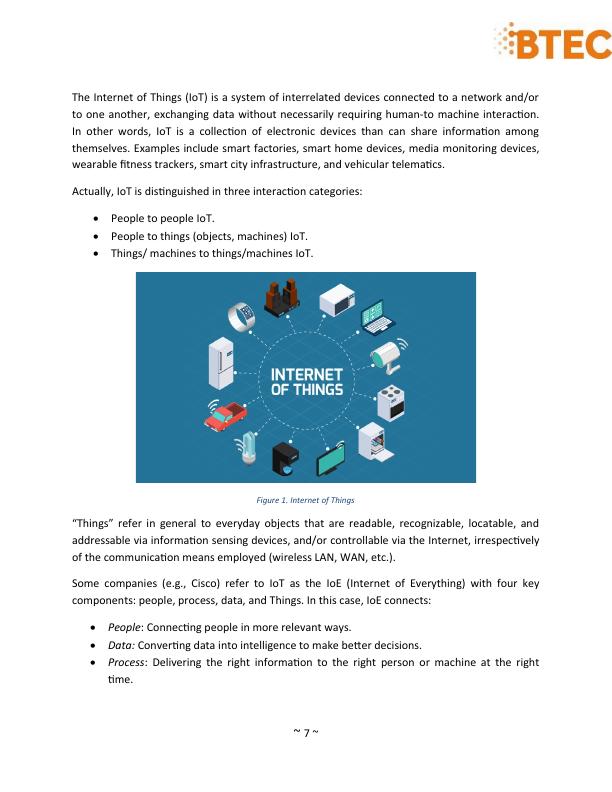Ask a question from expert
Unit 43: Internet of Things PDF
43 Pages9819 Words457 Views
Added on 2022-01-15
Unit 43: Internet of Things PDF
Added on 2022-01-15
BookmarkShareRelated Documents
ASSIGNMENT 1 FRONT SHEET
Qualification TEC Level 5 HND Diploma in Computing
Unit number and title Unit 43: Internet of Things
Submission date Monday, 21 June 2021 Date Received 1st submission
Re-submission Date Date Received 2nd submission
Student Name Do Thi Dieu Linh Student ID BHAF190198
Class BHAF1911-2.2 Assessor name Nguyen Thai Cuong
Student declaration
I certify that the assignment submission is entirely my own work and I fully understand the consequences of plagiarism. I understand
that making a false declaration is a form of malpractice.
Student’s signature Linh
Grading grid
P1 P2 P3 P4 M1 M2 M3 M4 D1 D2
~ 1 ~
Qualification TEC Level 5 HND Diploma in Computing
Unit number and title Unit 43: Internet of Things
Submission date Monday, 21 June 2021 Date Received 1st submission
Re-submission Date Date Received 2nd submission
Student Name Do Thi Dieu Linh Student ID BHAF190198
Class BHAF1911-2.2 Assessor name Nguyen Thai Cuong
Student declaration
I certify that the assignment submission is entirely my own work and I fully understand the consequences of plagiarism. I understand
that making a false declaration is a form of malpractice.
Student’s signature Linh
Grading grid
P1 P2 P3 P4 M1 M2 M3 M4 D1 D2
~ 1 ~

❒ Summative Feedback: ❒ Resubmission Feedback:
Grade: Assessor Signature: Date:
Internal Verifier’s Comments:
Signature & Date:
~ 2 ~
Grade: Assessor Signature: Date:
Internal Verifier’s Comments:
Signature & Date:
~ 2 ~

~ 3 ~

Table of Contents
I. Introduction..................................................................................................................................................................... 6
II. Explore various forms of IoT functionality......................................................................................................... 6
1. What is the Internet of Things?........................................................................................................................... 6
2. Internet of Things Characteristics..................................................................................................................... 8
3. IoT functionality........................................................................................................................................................ 9
3.1 Smart Homes: Tomorrowland Today..................................................................................................... 9
3.2 Smart Cars: Connecting on the Road.................................................................................................... 11
4 IoT Advantages and Disadvantages................................................................................................................ 14
III. Review standard architecture, frameworks, tools, hardware and APIs available for use in IOT
development. (P2)................................................................................................................................................................ 15
1. Internet of Things Architectures...................................................................................................................... 15
2. Internet of Things Framework......................................................................................................................... 16
3. Tools............................................................................................................................................................................ 18
4. IoT Hardware........................................................................................................................................................... 19
5. APIs techniques...................................................................................................................................................... 21
IV. Investigate architecture, framework, tools, hardware and API techniques available to
develop IOT applications................................................................................................................................................... 23
1. Investigate architecture...................................................................................................................................... 23
2. Investigate framework......................................................................................................................................... 26
3. Investigate tools..................................................................................................................................................... 27
4. Investigate hardware........................................................................................................................................... 29
5. Investigate APIs techniques............................................................................................................................... 31
V. Determine a specific problem to solve using IOT.......................................................................................... 32
1. The Scenario............................................................................................................................................................. 32
2. Objective.................................................................................................................................................................... 33
3. Proposed work........................................................................................................................................................ 34
4. Hardware used........................................................................................................................................................ 35
VI. Conclusion................................................................................................................................................................. 40
VII. References................................................................................................................................................................. 41
~ 4 ~
I. Introduction..................................................................................................................................................................... 6
II. Explore various forms of IoT functionality......................................................................................................... 6
1. What is the Internet of Things?........................................................................................................................... 6
2. Internet of Things Characteristics..................................................................................................................... 8
3. IoT functionality........................................................................................................................................................ 9
3.1 Smart Homes: Tomorrowland Today..................................................................................................... 9
3.2 Smart Cars: Connecting on the Road.................................................................................................... 11
4 IoT Advantages and Disadvantages................................................................................................................ 14
III. Review standard architecture, frameworks, tools, hardware and APIs available for use in IOT
development. (P2)................................................................................................................................................................ 15
1. Internet of Things Architectures...................................................................................................................... 15
2. Internet of Things Framework......................................................................................................................... 16
3. Tools............................................................................................................................................................................ 18
4. IoT Hardware........................................................................................................................................................... 19
5. APIs techniques...................................................................................................................................................... 21
IV. Investigate architecture, framework, tools, hardware and API techniques available to
develop IOT applications................................................................................................................................................... 23
1. Investigate architecture...................................................................................................................................... 23
2. Investigate framework......................................................................................................................................... 26
3. Investigate tools..................................................................................................................................................... 27
4. Investigate hardware........................................................................................................................................... 29
5. Investigate APIs techniques............................................................................................................................... 31
V. Determine a specific problem to solve using IOT.......................................................................................... 32
1. The Scenario............................................................................................................................................................. 32
2. Objective.................................................................................................................................................................... 33
3. Proposed work........................................................................................................................................................ 34
4. Hardware used........................................................................................................................................................ 35
VI. Conclusion................................................................................................................................................................. 40
VII. References................................................................................................................................................................. 41
~ 4 ~

Table of figures
Figure 1. Internet of Things.............................................................................................................7
Figure 2. IoT – more complete definition........................................................................................8
Figure 3. Illustration of Smart Home...............................................................................................9
Figure 4. Illustration of Smart cars................................................................................................12
Figure 5. The engine control unit from a BMW.............................................................................13
Figure 6. Major Components of IoT...............................................................................................17
Figure 7. Hardware Platforms for Internet of Things....................................................................19
Figure 8. IoT hardware - Wearable Electronic Devices..................................................................20
Figure 9. IoT hardware - Raspberry Pi 2........................................................................................21
Figure 10. ThingSpeak API.............................................................................................................23
Figure 11. IoT Architecture Layers and Components....................................................................24
Figure 12. IoT Framework..............................................................................................................26
Figure 13. Example for Tinkercad..................................................................................................27
Figure 14. Example for Posteus.....................................................................................................29
Figure 15. ESP8266 module...........................................................................................................30
Figure 16. Arduino Uno Board.......................................................................................................31
Figure 17. Arduino Rest API...........................................................................................................31
Figure 18. Illustrating the application of IoT in agriculture...........................................................33
Figure 19. Schedule of implementation off the project................................................................34
Figure 20. Block Diagram Proposed Work.....................................................................................34
Figure 21. Board Adruino Mega 2560............................................................................................36
Figure 22. LCD................................................................................................................................36
Figure 23. LCD I2C..........................................................................................................................37
Figure 24. HC-05 Bluetooth Module..............................................................................................38
Figure 25. Soil moisture sensor.....................................................................................................38
Figure 26. DHT11...........................................................................................................................39
Figure 27. Wi-Fi module.................................................................................................................39
~ 5 ~
Figure 1. Internet of Things.............................................................................................................7
Figure 2. IoT – more complete definition........................................................................................8
Figure 3. Illustration of Smart Home...............................................................................................9
Figure 4. Illustration of Smart cars................................................................................................12
Figure 5. The engine control unit from a BMW.............................................................................13
Figure 6. Major Components of IoT...............................................................................................17
Figure 7. Hardware Platforms for Internet of Things....................................................................19
Figure 8. IoT hardware - Wearable Electronic Devices..................................................................20
Figure 9. IoT hardware - Raspberry Pi 2........................................................................................21
Figure 10. ThingSpeak API.............................................................................................................23
Figure 11. IoT Architecture Layers and Components....................................................................24
Figure 12. IoT Framework..............................................................................................................26
Figure 13. Example for Tinkercad..................................................................................................27
Figure 14. Example for Posteus.....................................................................................................29
Figure 15. ESP8266 module...........................................................................................................30
Figure 16. Arduino Uno Board.......................................................................................................31
Figure 17. Arduino Rest API...........................................................................................................31
Figure 18. Illustrating the application of IoT in agriculture...........................................................33
Figure 19. Schedule of implementation off the project................................................................34
Figure 20. Block Diagram Proposed Work.....................................................................................34
Figure 21. Board Adruino Mega 2560............................................................................................36
Figure 22. LCD................................................................................................................................36
Figure 23. LCD I2C..........................................................................................................................37
Figure 24. HC-05 Bluetooth Module..............................................................................................38
Figure 25. Soil moisture sensor.....................................................................................................38
Figure 26. DHT11...........................................................................................................................39
Figure 27. Wi-Fi module.................................................................................................................39
~ 5 ~

I. Introduction
Each development stage of world history is associated with revolutions in science and
technology. And today, the Internet of Things revolution has created significant changes to
human life in the present and in the future. With the development of the Internet,
smartphones and especially sensor devices, the Internet of Things (IoT) is becoming a new
trend of the world. IoT is defined as devices that are able to connect to the Internet. You enter
the house, unlock the door, the lights will automatically turn on where you stand, the air
conditioner will automatically adjust the temperature, the music will automatically turn on to
welcome you... things only in sci-fi movies, are gradually becoming reality with IoT technology.
My assignment includes four parts:
Explore various forms of IoT functionality.
Review standard architecture, frameworks, tools, hardware and APIs available for use in
IoT development.
Investigate architecture, frameworks, tools, hardware and API techniques available to
develop IoT applications.
Finally, determine a specific problem to solve using IoT.
II. Explore various forms of IoT functionality
1. What is the Internet of Things?
The term “Internet of Things” (IoT) is now widely used, but so far there is not unique common
non-biased definition or understanding of what this term encompasses. There are many
different definitions of the expression “Internet of Things” which however have in common the
feature that is has to do with the integration of the physical world with the virtual world of the
internet. In its simple form, IoT may be considered as a network of physical elements
empowered by:
Sensors: to collect information.
Identifier: to identify the source of data (e.g., sensors, devices).
Software: to analyze data.
Internet connectivity: to communication and notify.
~ 6 ~
Each development stage of world history is associated with revolutions in science and
technology. And today, the Internet of Things revolution has created significant changes to
human life in the present and in the future. With the development of the Internet,
smartphones and especially sensor devices, the Internet of Things (IoT) is becoming a new
trend of the world. IoT is defined as devices that are able to connect to the Internet. You enter
the house, unlock the door, the lights will automatically turn on where you stand, the air
conditioner will automatically adjust the temperature, the music will automatically turn on to
welcome you... things only in sci-fi movies, are gradually becoming reality with IoT technology.
My assignment includes four parts:
Explore various forms of IoT functionality.
Review standard architecture, frameworks, tools, hardware and APIs available for use in
IoT development.
Investigate architecture, frameworks, tools, hardware and API techniques available to
develop IoT applications.
Finally, determine a specific problem to solve using IoT.
II. Explore various forms of IoT functionality
1. What is the Internet of Things?
The term “Internet of Things” (IoT) is now widely used, but so far there is not unique common
non-biased definition or understanding of what this term encompasses. There are many
different definitions of the expression “Internet of Things” which however have in common the
feature that is has to do with the integration of the physical world with the virtual world of the
internet. In its simple form, IoT may be considered as a network of physical elements
empowered by:
Sensors: to collect information.
Identifier: to identify the source of data (e.g., sensors, devices).
Software: to analyze data.
Internet connectivity: to communication and notify.
~ 6 ~

The Internet of Things (IoT) is a system of interrelated devices connected to a network and/or
to one another, exchanging data without necessarily requiring human-to machine interaction.
In other words, IoT is a collection of electronic devices than can share information among
themselves. Examples include smart factories, smart home devices, media monitoring devices,
wearable fitness trackers, smart city infrastructure, and vehicular telematics.
Actually, IoT is distinguished in three interaction categories:
People to people IoT.
People to things (objects, machines) IoT.
Things/ machines to things/machines IoT.
Figure 1. Internet of Things
“Things” refer in general to everyday objects that are readable, recognizable, locatable, and
addressable via information sensing devices, and/or controllable via the Internet, irrespectively
of the communication means employed (wireless LAN, WAN, etc.).
Some companies (e.g., Cisco) refer to IoT as the IoE (Internet of Everything) with four key
components: people, process, data, and Things. In this case, IoE connects:
People: Connecting people in more relevant ways.
Data: Converting data into intelligence to make better decisions.
Process: Delivering the right information to the right person or machine at the right
time.
~ 7 ~
to one another, exchanging data without necessarily requiring human-to machine interaction.
In other words, IoT is a collection of electronic devices than can share information among
themselves. Examples include smart factories, smart home devices, media monitoring devices,
wearable fitness trackers, smart city infrastructure, and vehicular telematics.
Actually, IoT is distinguished in three interaction categories:
People to people IoT.
People to things (objects, machines) IoT.
Things/ machines to things/machines IoT.
Figure 1. Internet of Things
“Things” refer in general to everyday objects that are readable, recognizable, locatable, and
addressable via information sensing devices, and/or controllable via the Internet, irrespectively
of the communication means employed (wireless LAN, WAN, etc.).
Some companies (e.g., Cisco) refer to IoT as the IoE (Internet of Everything) with four key
components: people, process, data, and Things. In this case, IoE connects:
People: Connecting people in more relevant ways.
Data: Converting data into intelligence to make better decisions.
Process: Delivering the right information to the right person or machine at the right
time.
~ 7 ~

Things: Physical devices and objects connects to the Internet and each other for
intelligent decision-making, often called IoT.
Figure 2. IoT – more complete definition
2. Internet of Things Characteristics
The fundamental characteristics of the IoT are as follows:
Connectivity: Connectivity makes possible network accessibility and compatibility.
Anything can be interconnected with the overall IoT communication and information
facilities. Compatibility means that “things” have the common ability to generate and
consume data.
Safety: IoT must be designed to ensure the security of personal data, physical safety and
human health. Secure endpoints, networks, and the data in transit, implying that we
create a security model at scale.
Heterogeneity: The devices in the IoT are heterogeneous as based on different hardware
platforms and networks. They can interact with other devices or service platforms
through different networks.
Dynamic changes: The state of devices change dynamically, (e.g., alternating connection
and disconnection, changing position and speed, etc.).
Tremendous scale: The number of things and IoT devices that communicate and interact
with each other, and have to be managed, is at least one order of magnitude bigger
than that of the present internet.
~ 8 ~
intelligent decision-making, often called IoT.
Figure 2. IoT – more complete definition
2. Internet of Things Characteristics
The fundamental characteristics of the IoT are as follows:
Connectivity: Connectivity makes possible network accessibility and compatibility.
Anything can be interconnected with the overall IoT communication and information
facilities. Compatibility means that “things” have the common ability to generate and
consume data.
Safety: IoT must be designed to ensure the security of personal data, physical safety and
human health. Secure endpoints, networks, and the data in transit, implying that we
create a security model at scale.
Heterogeneity: The devices in the IoT are heterogeneous as based on different hardware
platforms and networks. They can interact with other devices or service platforms
through different networks.
Dynamic changes: The state of devices change dynamically, (e.g., alternating connection
and disconnection, changing position and speed, etc.).
Tremendous scale: The number of things and IoT devices that communicate and interact
with each other, and have to be managed, is at least one order of magnitude bigger
than that of the present internet.
~ 8 ~

End of preview
Want to access all the pages? Upload your documents or become a member.
Related Documents
Unit 43: Internet of Things PDFlg...
|38
|5839
|237
Unit 11 Research Project: Assignmentlg...
|46
|13848
|109
Unit 9: Software Development Life Cyclelg...
|46
|9041
|1314
Quadcopter with Camera: Design, Implementation, and Applicationlg...
|56
|12253
|131
The Transformation to Digital bank of Lecturer Ngo Quy Nham Course QTRE304 Group Member Nguyen Minh Cong - 1815280031 Pham Trung Dung - 1810280006 Le Huong Giang - 1810280006 Tran Long Vulg...
|31
|6506
|437